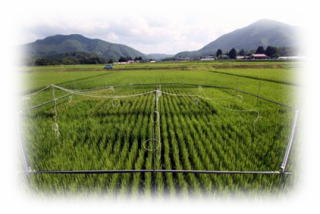![]()
![]()
![]()
![]()
Paddy fields act as an important carbon-cycling interface between the atmosphere and the land. Carbon dioxide (CO2) fixation by photosynthesis provides staple foods to half the world's population, and rice is one of the most important cereal crops, especially in Asian countries. Increasing world population needs further extension of rice cultivation. On the other hand, the paddy-field landscape is one of the major sources of atmospheric CH4, the second most important greenhouse gas. The radiative forcing of CH4 is as much as half that of CO2 if indirect effects are taken into account (stratospheric H2O and tropospheric ozone). Rice paddies are estimated to account for 15–26% of the anthropogenic CH4 release and 9–19% of total global emissions.
Growing evidence has shown that global change would further stimulate CH4 emission from rice paddy through two important mechanisms. First, increasing temperature would increase the activity of methanogenesis, and second, increasing atmospheric CO2 concentration ([CO2]) enhances growth of rice, resulting in greater amount of rhizodeposition (root exudation and autolysis products). Understanding the degree of this"positive feedback" is very important for predicting future climate.
Our institute, National institute for Agro-Environmental Sciences (NIAES), has conducted the world's first free-air CO2 enrichment (FACE) experiment for irrigated rice since 1998 in a farmer's field located in Shizukuishi, Iwate, Japan. This FACE system allows us to see the future rice-farming ecosystem under the elevated [CO2] condition (+ 200 ppm). In 2007 and 2008, we introduced water and soil temperature elevation system so that we could mimic the warming world (+2°C) as well as high [CO2]. Currently I'm studying several topics listed below.
- Effect of high [CO2] and elevated soil temperature on CH4 emission: empirical investigation under fully open-air condition.
- Effect of soil warming on the soil organic matter decomposition.
- Stoichiometric study for organic matter decomposition in rice-paddy soil, with special emphasis on iron (Fe (III)) reduction and CH4 production and their competition processes.
- FACE-induced less 13C as a partitioning tracer for determining sources of carbon metabolites (CO2 and CH4) in a rice paddy field: separation of recent photo-assimilates and endogenous organic matters (soil organic matter, plant residue, organic fertilizer).
- Carbon source separation by in situ incubation: understanding the contribution of SOM and plant residues (straw and stubble).


The Shizukuishi rice-FACE project was over by 2008, but we are now planning to start new rice-FACE project in Tsukubamirai, Ibaraki, Japan.
![]()
![]() Carbon stable isotope analysis (CO2, CH4)(July. 19, 2009)
Carbon stable isotope analysis (CO2, CH4)(July. 19, 2009)